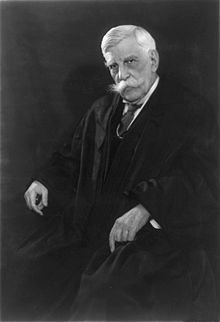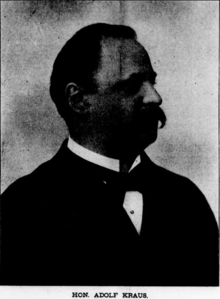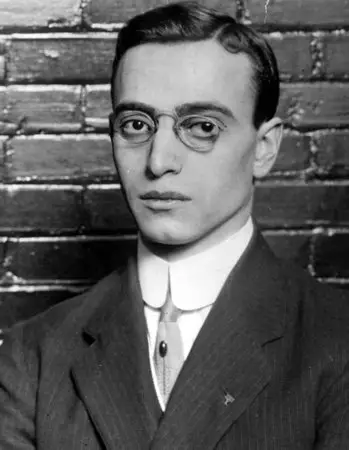
Frank
Headlines!
A catastrophe of antisemitism, poor police work, racism, and class warfare, Frank (a Jewish-American born in Cuero, Texas ... the family moves to Brooklyn when he is only three months old ... so to most of his fellow Atlantians, Frank is a northern "Yankee Jew" that marries into one of Atlanta's leading Jewish families) is the superintendent of an Atlanta, Georgia pencil factory (partially owned by his uncle, Moses Frank) that Phagan labors at for ten cents an hour through a 55-hour work week. Laid off because of a shortage of brass sheet metal, Phagan shows up at the factory on 4/26/1913 to claim the $1.20 the company owes her ... and never returns home. Discovered shortly after 3:00 in the morning when the night watchman, African-American Newt Lee, descends into the basement to use a toilet located there ... Phagan is found dead, her dress up over her waist, with a piece of her petticoat torn away and wrapped tightly around her neck, her underwear still around her hips, but bloody and torn open, her face, scratched and so black that authorities at first believe they are investigating the murder of an African-American. In the first arrest of many to come for the crime, Lee is taken into custody.
Phagan
In the investigation that follows (which the Pinkerton National Detective Agency assists on), some clues are missed, and some evidence is destroyed (for instance, footsteps in a trail of dirt leading to the elevator are compromised), and other evidence appears planted (two "found" letters near Phagan's head that seem to imply that either Lee, or 27-year-old African-American janitor, Jim Conley, were involved in the crime) ... eventually though, the authorities focus in on Frank ... Phagan's boss, the last man purported to have seen Phagan alive, a man who seems nervous when questioned and gives some answers that can't be collaborated, and a boss that employees identify as being very flirtatious with the females under his guidance. And it soon gets worse for Frank, when Conley confesses to helping Frank move Phagan's body to the basement (most scholars of the case now believe the actual killer was Conley, who gives four different statements, none of which match each other, to authorities ... he comes to the attention of those authorities when he is caught washing blood off of one of his shirts ... that actually proves to be just a rust stain) after the girl's murder. Arrested, Frank's farce of a trial for murder begins on 7/28/1913 in the Fulton County Superior Court under the guidance of Judge Leonard S. Roan.

Conley

Ass Backwards, Guilty Until Proven Innocent!!!!!!!!!!!!
At trial, the defense (Frank is represented by eight lawyers) and prosecution clash over whether the murder took place on the second floor (where Frank's office is located) or in the basement, over Conley's involvement, the whereabouts of Phagan's missing purse, the cause of a black eye on Phagan's corpse, whether the girl was raped or not, an analysis of the contents of the corpse's stomach, whether Frank regularly had sex with his employees in his office, and the timeline for the crime (in several, Frank does not have enough time to have killed Phagan, and yet be where witnesses testify to his presence during the day). For the most part though, the jury is swayed by Conley's testimony (he will hold to his story of Frank being the murderer through sixteen hours of cross examination by the defense over the course of three days), not the holes in his story the defense identifies (it is believed to be the first time a southern jury takes the words of a black man over those of white man ... but the jury doesn't see a white man in Frank, to them, he is a northern carpetbagging Jew in massive need of punishment) and he is found guilty of Phagan's murder on 8/25/1913. The next day, in his private chambers, Judge Roan sentences Frank to death by hanging. Showing the extent of the feelings against Frank, when the verdict is announced to the crowd that has gathered outside the courtroom, it treats the prosecutor, Hugh Dorsey, as if he were the home town's winning pitcher in the deciding game of the World Series, by passing him over the heads of the cheering crowd to the street below the courthouse (recognizing his popularity, Dorsey will run for a bigger office and become the state of Georgia's governor in 1917).

In Court - 7/28/1913

Dorsey
All White Male Jury That Convicts Frank
But as with most capital cases, the trial and sentencing are only round one in the quest to see justice done. Immediately after sentencing, Frank's legal team launches a series of appeals over evidence and procedures that goes first to Judge Roan (he denies it of course since it deals with the right and wrong found in his own court), passes on to the Georgia Supreme Court, and eventually ends up in the docket of the United Supreme Court ... which rejects the appeal 7-2 on a timing technicality (with Justice Oliver Wendell Holmes Jr. weighing in that he doesn't believe Frank had received a fair trial ... "It is our duty to declare lynch law as little valid when practiced by a regularly drawn jury as when administered by one elected by a mob intent on death." ... prescient words indeed).

Holmes
Death by hanging Frank's future once more, the governor of Georgia, John Slaton, gets involved in the case, overseeing a sentence commutation hearing in June of 1915 (during which he receives more than 1,000 death threats), in which he will eventually change the sentence to one of life in prison. And the happy crowds of Georgians that celebrated the verdict and original sentencing then turn hateful and bitter ... and start plotting their own end for Frank, especially after it is discovered that the governor has ties to the law firm that defended the man (to his dying day, Slaton the connection informed his decision at all) ... passions that become even more incensed as various northern newspapers and law firms weigh in on the apparent racism and bigotry of Georgia (a mob will try to assault the governor's mansion, but will be turned aside by members of the state's National Guard and various local members of law enforcement).

Slaton And Wife
The entire state a steaming boiler ready to explode, the detonation comes on 8/17/1915, when a group calling itself "The Knights of Mary Phagan" visits the Milledgeville Prison where Frank is incarcerated ... a group that includes an electrician to cut the prison's power, car mechanics to keep the mob's cars running on the drive from the town of Marietta to the prison and back (a back that entails a 175 mile drive on back roads that takes roughly seven hours to complete), a medic, a locksmith, a telephone lineman, a hangman, and a lay preacher, overseen by such sterling citizens as Joseph Mackey Brown, the former governor of the state, Eugene Herbert Clay, the former mayor of Marietta, E. P. Dobbs, Marietta's current mayor, and Marietta lawyer and banker, Moultrie McKinney Sessions.

Milledgeville Prison

Former Governor Brown
Planned like a military operation, the mob's eight cars arrive at the prison at around 10:00 in the evening and everyone immediately jump to their tasks ... telephone wires at and in the vicinity of the prison are cut, to prevent pursuit, gas is drained from cars in the prison's parking lot, the warden is handcuffed and locked away, and Frank is grabbed from his cell and placed in the back seat of one of the cars for the journey back to Marietta. At an already prepared site (a rope and a table are supplied by former Sheriff William Frey) just a few miles east of Marietta, Frank is taken out of his ride, handcuffed, his legs are tied at the ankles, and quickly lynched to the glee of a crowd numbering in the hundreds (facing towards the home Mary Phagan once lived in). Vigilante justice completed, the moment is then documented with photos being taken that will be published as postcards selling for 25 cents each. Body finally lowered from its fatal perch, one onlooker goes berserk wanting to join in on the action, and stomps on Frank's head and chest until the corpse can be placed in a car and begin its journey back to New York City for burial. Incredibly, no one is ever officially identified as participating in the hanging, or prosecuted for the crime ... despite photos and other evidence of the gross misdeed being easily available to the authorities.


Frank And Some Of The Mob
Headlines!
And murder seeds flowering, in the aftermath of the lynching, Adolf Kraus will form the Anti-Defamation League, a group dedicated fighting anti-Semitism and all forms of bigotry that still is in existence, while in ceremonies atop Stone Mountain led by William Joseph Simmons, complete with a burning cross, the Knights of Mary Phagan morphs into a revival of the Klu Klux Klan in Georgia ... sadly still in existence too! The suspected real culprit in the death of Mary Phagan (Phagan's family still believes Leo Frank was her killer), James Conley, serves a year on a chain gang for his confession of involvement in moving the body, is sentenced to 24 years behind bars for trying to burglarize an Atlanta drug store in 1919 (some of the years are thought to be Georgia payback for his lite sentencing in the Phagan case), and finally passes away in 1962.

Kraus - 1896

Simmons
As for Frank, his infamous case is still studied at law schools around the country, and in 1986, far too late to do the pencil factory superintendent any good, egged on by the Anti-Defamation League, he receives a posthumous pardon from the Georgia State Board of Pardons and Paroles.

Frank
Memorial
No comments:
Post a Comment